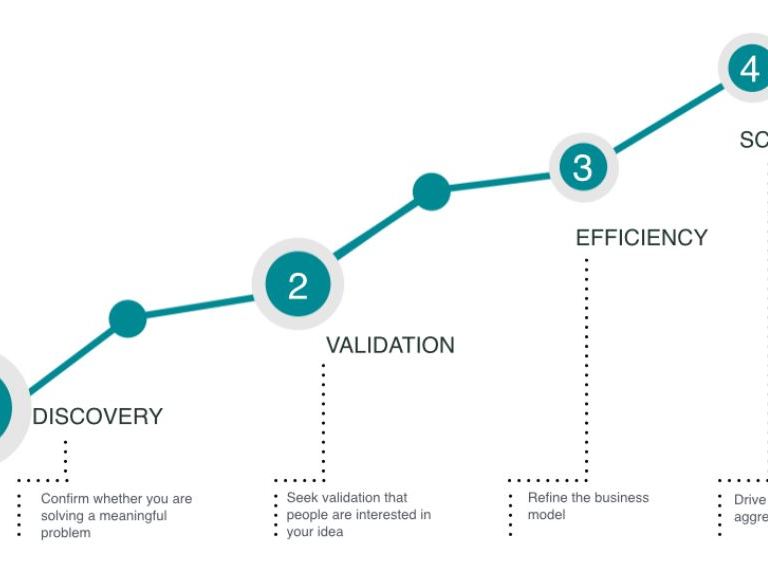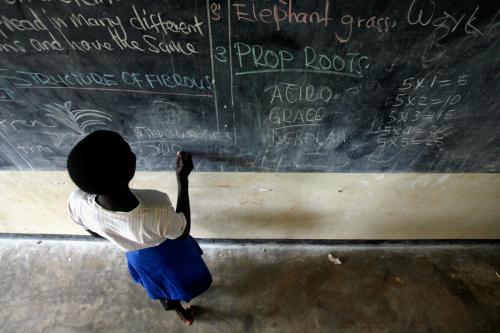Although we are still many months away from a return to normal, the approval of a COVID-19 vaccine has signaled an end to this crisis. While schools will reopen and social distancing guidelines will be lifted, the impacts of the pandemic will endure, and we should not let innovations forged in the era of COVID-19 fall by the wayside. The education sector has been pushed to innovate faster than ever before, and while many of our solutions were developed in response to the pandemic, the lessons learned are critical to building more equitable education systems.
Targeting impact in the COVID era: A rapid approach to program development
The COVID-19 crisis put our youth skills organization, Educate!, effectively out of business. We worked directly within education systems and secondary schools, and new restrictions meant we had to pivot to an entirely new mode of program delivery and—to do so quickly— a more agile program development process.
While our previous program development process was methodologically solid, it wasn’t going to cut it. We needed to develop an entirely new program model—fast. The nature of the crisis meant it was critical to work with speed and flexibility, so we created autonomous product teams that immediately jumped to product development “sprints” based on Scrum and Lean Startup methodologies—running experiments to test the feasibility and effectiveness of distance learning strategies such as radio lessons, conference calls, SMS (text), unstructured supplementary service data, learning prompts, and more.
With our teams in place, we approached model development in three stages, with each stage mapped to a key question (Figure 1):
Figure 1. How should the product evolve
 Source: Medium
Source: Medium
1) Discovery/validation: Can we design something that reaches youth and solves a problem?
2) Efficiency: Does the model measurably impact youth when implemented at greater scale?
3) Scale: When submitted to a rigorous test and delivered at large scale, do implementation and impact hold up?
To answer these questions, we took skill measurements from pre-validated tools and best practices in remote data collection to build a Rapid Impact Assessment (RIA) system. The RIA connects changes in program delivery directly to outcomes by measuring short-term indicators we know from past evaluations to lead to longer-term outcomes for youth.
With systems in place, soon we developed best practices of our own, and over time began to make meaningful progress.
After countless experiments, a breakthrough
After throwing everything at the wall, finally something stuck. This past October, we received encouraging results from a boot-camp program delivered through conference call, which we piloted with 3,000 youth. Through an internal pre-/post-evaluation, we found that youth who completed the boot camp saw improvements within key economic outcomes, including a 77 percent increase in earning any income, a 33 percent increase in putting aside any savings, and a 137 percent increase in running a business. Youth also experienced improvements in knowledge, beliefs, and skills important for success outside of school. While we have lots more learning to do and there are important caveats from a pre-post evaluation, we found these results encouraging, as they not only provided initial validation of our model and process, but generated insights that should serve wider education systems.
Leveraging the pandemic response to strengthen the future of education
This crisis has placed quality education and equitable access at center stage, and we believe our experimentation journey highlights useful learnings, not just for NGOs, but for governments, policymakers, and educational designers looking to tackle issues of equity and expand access to learning.
1. Effective remote learning experiences can work in lower-resource settings
Although it is our hope that the pandemic will push education systems further into the 21st century and toward a more equitable future, the reality of universal access to secondary education may take years to materialize. While distance learning will never substitute for high-quality in-person education entirely, our experience during the pandemic showed us that youth don’t need a traditional classroom to develop skills. The experience of many organizations demonstrates that top-tier technology or extensive in-person training is preferred, but not critical, to provide a meaningful learning experience—a traditional phone line could be enough. National governments and education policymakers should explore new flexible educational models that can expand access and strengthen quality—just imagine a government-run call center staffed by youth delivering educational support, or providing supplemental mentorship to in-school students.
2. Experimentation and iterative learning shouldn’t stop when students return to the classroom—they should continue with a focus on universal access to post-primary education
While we are all eager to get back to the classroom, the return to normal doesn’t mean we should settle back into old habits. We need to think critically about how the strategies, approaches, and initiatives we’ve tested during the pandemic can blend back into existing education systems. National education call centers are one idea, and supplemental SMS assessment and learning for youth is another. Overall, there are a number of innovations and learnings from across the sector that have the potential to contribute meaningfully to progress toward equity goals that have long eluded us.
3. Nonformal education holds promise for millions of out-of-school youth
In just nine months, we developed a new cost-effective model with real and measurable impacts on youth. We found that this model was not only effective for reaching Educate!’s in-school participants but also youth outside our target population within formal education. We should leverage learnings from this time to expand access to more marginalized youth, such as girls. Learning should not be a luxury, and we have long needed additional and inclusive pathways to prepare the millions of youth unable to attend traditional secondary school for the world of work. For example, what if national education systems complemented in-school programming with affordable, remote programs for girls unable to reach the classroom, or implemented flexible skills-based boot camps to support out-of-school youth as they transition to employment within industries without smokestacks?
The path forward
Since the turn of the 20th century our education systems have remained largely unchanged, but with no other choice but to innovate this past year, we’ve pushed antiquated systems further into the 21st century. As young people return to the classroom, we must commit ourselves to continuing to conduct rapid experiments, incorporate what works, and use newfound tools to build more equitable education systems for all.







Commentary
How COVID-era innovation can build more equitable education systems
February 9, 2021